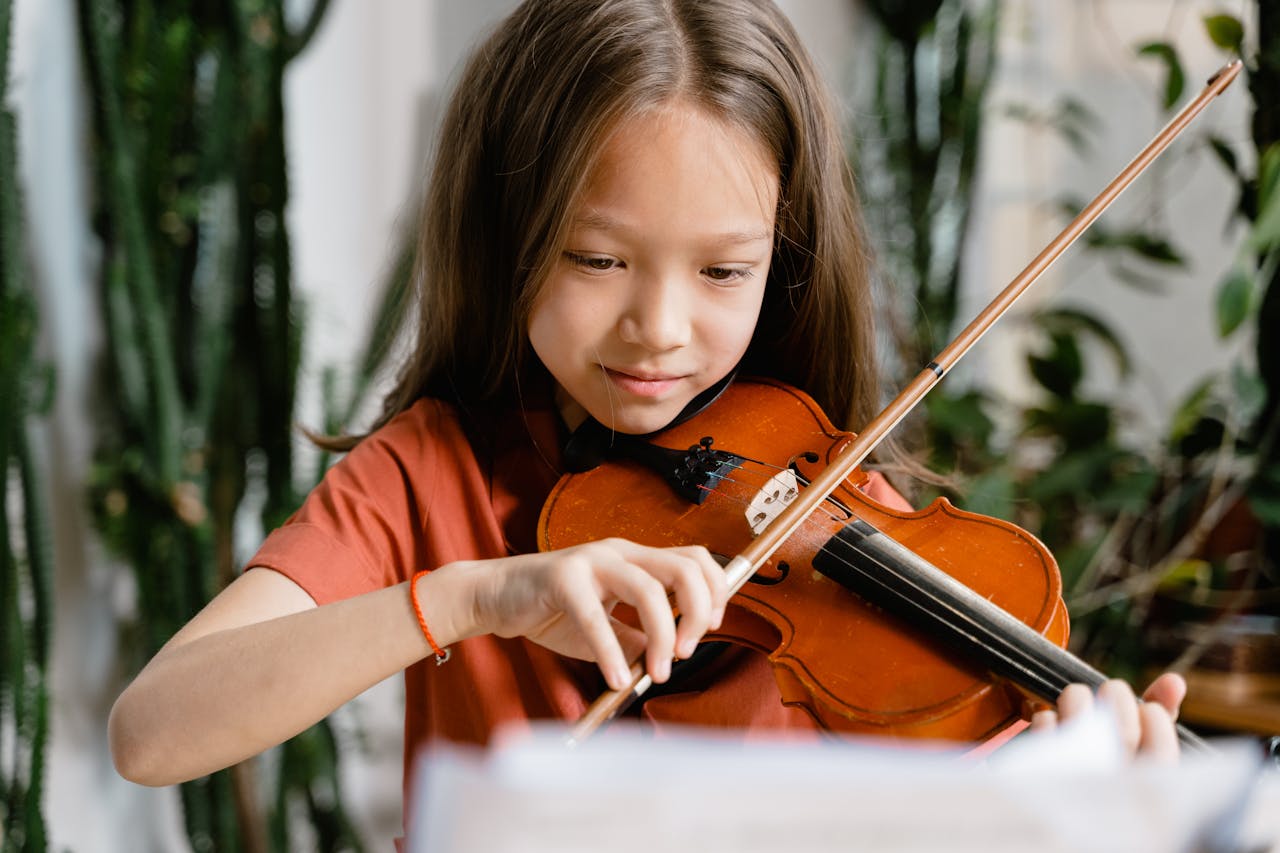- Parents can support their child’s violin journey by creating a positive environment, encouraging consistent practice, and focusing on growth instead of perfection.
- Encouragement, variety, and positive communication help children stay motivated while developing independence and creativity in their violin practice.
- Chris Heins Strings Studio partners with families to guide children toward meaningful progress, confidence, and joy through thoughtful violin instruction.
Learning the violin is one of the most rewarding paths a child can take in music. It is a challenging instrument, requiring patience, consistent practice, and strong guidance. Parents play a critical role in shaping the success of their child’s violin journey, particularly when the majority of learning happens outside of lessons. A supportive environment at home can make the difference between a child developing a lasting love for music or losing motivation.
This blog explores in depth how parents can actively and thoughtfully support their child’s violin studies at home. From creating an encouraging practice routine to fostering a healthy relationship with discipline and creativity, the strategies here are designed to be both practical and inspiring.
Creating a Positive Practice Environment
The first step to helping a child succeed with the violin is ensuring that their practice environment at home sets the right tone. Children absorb cues from their surroundings, and a well-prepared space encourages consistency.
Choose a room with good lighting, minimal distractions, and enough space for the violin, bow, and music stand. Parents may overlook the importance of physical comfort, but posture and focus are influenced by the space. A cramped corner or noisy environment makes practicing more stressful than necessary.
Having a designated space signals to the child that violin practice is valued in the home. The presence of a music stand, a chair suited for playing, and a shelf for books and sheet music can create a sense of ownership. Just as athletes thrive with proper training equipment, young violinists benefit from having the tools and setting they need.
Building a Consistent Practice Routine
One of the greatest challenges for young musicians is developing consistency. Parents can make a significant impact by helping establish a predictable routine. Violin progress depends on regular practice, but length and structure matter as much as frequency.
For younger children, short sessions of 10 to 15 minutes spaced throughout the day can be more effective than one long session. As children grow, sessions can gradually extend to 30 or 45 minutes, depending on age and concentration level. A daily practice habit is far more effective than irregular bursts of effort.
Parents should treat practice time with the same importance as schoolwork or sports practice. When a child sees that their parent prioritizes violin practice, they learn to value it too. Gentle reminders, consistency in scheduling, and shared encouragement all reinforce the idea that progress is built through steady effort.
Encouragement Over Perfection
Children often struggle with frustration when progress feels slow or when mistakes pile up. Parents can ease this challenge by focusing on encouragement rather than perfection.
Instead of pointing out every error, highlight the moments when the child demonstrates improvement. Acknowledging small successes, such as smoother bowing or improved intonation on one passage, motivates children to keep going. Overemphasis on mistakes can make the child associate practice with stress rather than growth.
Parents can also model patience by reminding their child that mastery takes time. Using comparisons outside of music can help. For example, learning a violin scale can be compared to practicing soccer drills or working through math problems. Relating the challenge to familiar experiences reassures children that learning is a process.
Understanding the Teacher’s Role
Parents who want to support their child at home should maintain open communication with the violin teacher. Teachers set expectations, provide techniques, and guide long-term development. Parents who understand the goals outlined in lessons can better reinforce them at home.
It can be useful to attend lessons, take notes, or ask the teacher how best to support the child. For younger students, teachers often provide practice assignments or specific focus points. Following these instructions carefully ensures that home practice aligns with professional guidance.
This partnership between teacher and parent fosters continuity. A child benefits when the adults around them present consistent expectations and encouragement. Instead of guessing what to emphasize, parents can reinforce exactly what the teacher intends.
Listening to Music Together
Exposure to violin music outside of practice broadens a child’s appreciation. Parents can nurture this by listening to recordings together. Playing classical pieces, contemporary violin performances, or recordings of great musicians gives children role models and inspiration.
Parents can also encourage children to notice different qualities of playing, such as tone, dynamics, and expression. Asking questions like “What do you notice about how the musician plays softly?” encourages active listening. Even young children can begin to form opinions about style and artistry, which supports their growth as musicians.
Attending live performances can be equally inspiring. Concerts provide tangible proof that the skills learned at home connect to real artistry. Children who see professionals perform are often motivated to continue practicing.
Helping With Practice Without Taking Over
Parents sometimes struggle to know how much to intervene during practice. The key is to support without taking over. Young musicians need autonomy, but they also benefit from gentle guidance.
If a child is working through a difficult section, a parent can encourage them to slow down or break it into smaller parts. Asking questions such as “Do you want to try that again at a slower pace?” empowers the child to think about problem-solving strategies rather than being told what to do.
Parents should also resist the urge to compare siblings or set unrealistic expectations. Every child progresses differently. Support means helping the child grow at their own pace rather than pushing them to meet someone else’s standard.
Introducing Fun and Variety
Violin practice need not feel like a chore. Parents can keep motivation alive by introducing variety. Alongside structured exercises, children can explore simple improvisation, play duets with parents or siblings, or learn pieces they recognize from movies or television.
For example, a child working on scales can also spend a few minutes experimenting with different rhythms or dynamics. This keeps practice sessions lively and develops musical creativity. Allowing space for fun alongside discipline helps children view the violin as both skill-building and joyful.

Managing Practice Challenges
Every child faces hurdles in their violin journey. Some may resist practicing, while others may grow discouraged by slow progress. Parents can approach these challenges thoughtfully by identifying the root causes.
If resistance arises from boredom, variety in practice content may help. If frustration comes from difficulty, breaking down tasks or adjusting expectations can relieve pressure. Sometimes the issue lies outside of music entirely, such as fatigue or competing responsibilities.
Instead of viewing reluctance as disobedience, parents can approach it as a signal that something in the routine needs adjustment. By staying flexible and empathetic, parents maintain the child’s long-term commitment.
The Role of Positive Language
The language parents use around practice shapes a child’s mindset. Encouraging phrases such as “I noticed you worked really hard on that part” or “That sounded smoother than yesterday” promote a growth-oriented outlook.
Avoid framing practice as punishment or obligation. Instead, present it as a valuable opportunity. For instance, instead of saying “You have to practice before you can go outside,” a parent might say, “Let’s do your practice now so you can enjoy your free time after.”
Small shifts in phrasing can transform the child’s perspective on practice from duty to opportunity.
Encouraging Independence Over Time
As children mature, they should gradually take more responsibility for their own practice. Parents can guide this transition by encouraging planning skills. Asking the child how they want to structure their session or what piece they want to start with builds independence.
A practice journal or log can also be useful. Children can track what they worked on, reflect on progress, and set small goals. Parents can encourage this without micromanaging, creating a balance between accountability and independence.
By fostering ownership of their practice, parents prepare their child for a lifelong relationship with music.
Using Technology Thoughtfully
Technology can play a supportive role in violin practice. Tuning apps, metronomes, and video recordings are helpful tools. Parents can assist their child in using these resources effectively without letting technology dominate the process.
Recording practice sessions allows children to hear their progress and notice areas for improvement. A metronome teaches steady rhythm, while tuning apps help develop ear training. However, technology should enhance practice rather than replace careful listening and self-reflection.
Parents can guide children in striking a balance, showing that tools are aids, not shortcuts.
Supporting Emotional Connection to Music
Beyond skills, the violin journey is deeply emotional. Parents can help their child connect to the expressive side of music. Asking how a piece makes them feel or encouraging them to imagine a story behind the melody helps deepen musical understanding.
When children experience music as a form of expression rather than a task, they begin to see the violin as part of their identity. Parents who nurture this connection give their child something that lasts far beyond technique.
Balancing Discipline and Joy
Successful violin learning depends on striking the right balance between discipline and joy. Too much pressure leads to burnout, while too little structure prevents progress. Parents must walk this line with care.
The most supportive approach is one that combines clear routines with freedom for exploration. Parents can set expectations about daily practice while also leaving space for creativity and fun. This balance allows children to grow technically while retaining their love for music.
Long-Term Growth and Perspective
Parents who support their child’s violin journey should remember that progress is long-term. Breakthroughs often happen gradually, and mastery builds over years.
Keeping perspective helps avoid frustration. The violin is considered one of the most complex instruments to learn, and each small milestone deserves recognition. Parents who celebrate these milestones teach their children resilience and persistence.
Ultimately, the goal is not simply technical mastery but the development of a meaningful relationship with music. Parents who nurture consistency, encouragement, and joy give their child a gift that will enrich their entire life.
Conclusion
Supporting a child’s violin journey at home is a rewarding responsibility. Parents provide the environment, encouragement, and structure that transform lessons into lifelong skills. By focusing on consistency, positivity, and a balance between discipline and joy, families can help children thrive both musically and personally.
With the right support, a child not only learns to play an instrument but also develops confidence, patience, and a deep love for music. Parents are the steady partners who make that journey possible.
At Chris Heins Strings Studio, I believe every child deserves thoughtful guidance in their violin journey. Partner with me to nurture consistent progress, creativity, and confidence through music. Contact me and let me help your child grow into a joyful and skilled musician.

